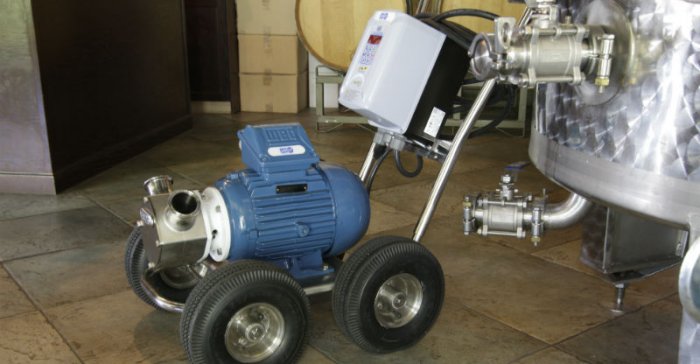
Pumps are used in many beverage and food process applications. For example, egg whites, honey, food oils, apple sauce, apple juice, donut glaze and pancake batter are all moved using pumps. Pumps can also be used to gently circulate fluid when fermenting high alcohol beer where oxygen is injected into the process to significantly reduce the fermentation time.
Pumps can provide a winemaker with the ability to transfer just-harvested grapes from a de-stemmer/crusher to the tank for fermentation. They can also be used for pump overs in fermentation tanks to allow for color enhancement on red wines and providing a way to move the juice from the tank to barrels for aging.
Pumps are also used to move the wine to the filtering process to remove sediment or solids and then to move the wine to the bottling line for packaging. Regardless of the style, pumps provide time savings to the winemaker and should be considered part of the wine production lifeline.
The winemaker should choose a pump that has the greatest versatility for the particular operation. A versatile pumpâone that can run at variable speeds and provide a winery with multiple task fulfillment capabilitiesâis a cost advantage to a winemaker. Some other advantages of a versatile pump are self-priming, reversible flow, portability and ease of cleaning.
This article discusses some typical pumps found in the wine industry. However, they can also be used in other food and beverage industry segments. Pump styles can be offered in flow ranges from a trickle to hundreds of gallons per minute and with AC or DC voltages.
Pumps can be obtained as a pump alone, with the motor attached and or mounted on a cart for ease of movement within the winery. Some pumps offer low pressure and some can produce high discharge pressures. Picking the flow and pressure to meet the needs of the application is important for successful and continuous production.
Flexible Impeller Pumps
Flexible impeller pumps (FIPs) are self-priming with either wet or dry at start up. They offer gentle, smooth and variable flow rates. This design includes a flexible impeller that rotates in a fixed cavity. The use of an offset cam causes the vanes on the impeller to deflect, decreasing the cell volume initially.
When the vanes leave the cam contact, the volume increases between the vanes, and fluid is drawn into the larger cell cavity with the help of atmospheric pressure. As the impeller rotates, it reduces the cell volume at the discharge port on contact with the cam.
Each cavity then produces a nearly-even and perfect smooth flow and is repeated on each revolution of the impeller. These pumps can transfer solids suspended in liquid. They are reversible and can be mounted above or below the liquid source. The fluid has contact with the rubber flexible impeller and the interior of the body housing. Pump bodies and materials, preferably, should be manufactured from sanitary stainless steel with sanitary rubber compounds. These are positive displacement pumps.
A portable, flexible impeller pump used in wine production
Rotary Lobe Pumps & External Circumferential Piston Pumps
Rotary lobe pumps and external circumferential piston (ECP) pumps, positive displacement pumps, offer high efficiency, gentle pumping action and corrosion resistance. These pumps are reliable and can be cleaned in place (CIP) or steamed in place (SIP). Rotary lobe pumps are capable of handling thick or thin solids, liquids and paste products. Some models of rotary lobe pumps perform well on self-priming if wetted. They can produce significant pressure.
These pumps, like FIPs, can have the direction of fluid flow reversed. Run dry capability is possible if the seals are wetted during the run dry timeframe. Rotary lobe pumps have two alternating direction rotating rotors that mesh in operation. The fluid or product flows into the pump and is captured by the rotating lobes. The product is transferred in the cavities around the outside of the lobe body. The product does not effectively travel between the meshing actions of the two lobes.
Centrifugal Pumps
Centrifugal pumps use gravity to push water into the pump cavity, and the high speed of the pump impeller then discharges the fluid from the discharge port. These pumps tend to be the most efficient with a smooth, pulse-free delivery. Minimal wear is associated with the pump components, the impeller and pump head are generally easily disassembled.
Most centrifugal pumps are small, but can produce a high volume of flow. Most can be obtained in AC and DC versions and are relatively inexpensive. The main draw back to centrifugal pumps is that they are not self-priming and may cavitate easily. The most common form of centrifugal pumps is a radial flow design.
Air-Operated Diaphragm Pumps
Air-operated diaphragm (AOD) pumps use air to power them. The pump design is self-priming, capable of handling high solids content, can run dry, is portable, explosion proof, has a high pumping efficiency and can deliver a variable flow rate and discharge pressure. One disadvantage is the requirement to have an air compressor on hand for use. This is a positive displacement pump.
Written by:
Keith Evans, Jabsco Flexible Impeller Pumps, Xylem, Inc.
Courtersy of: http://www.pump-zone.com/topics/pumps/pumps/wine-industry-pumps


